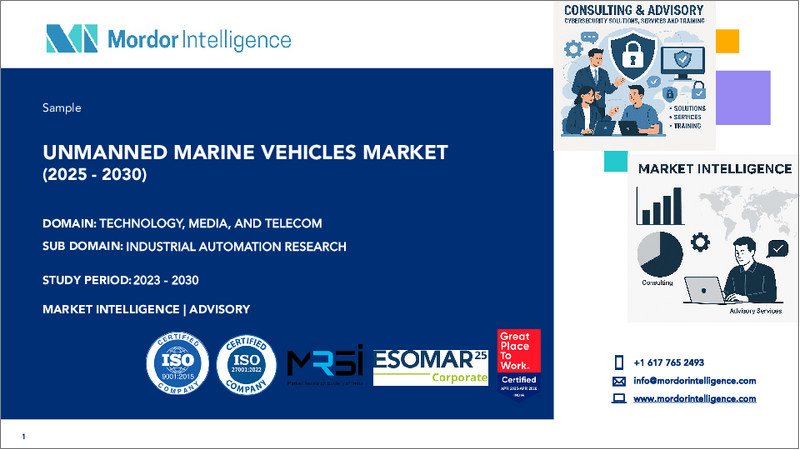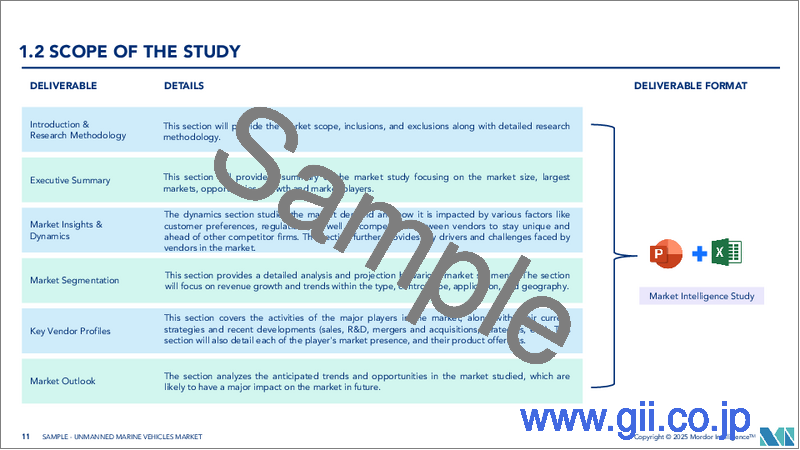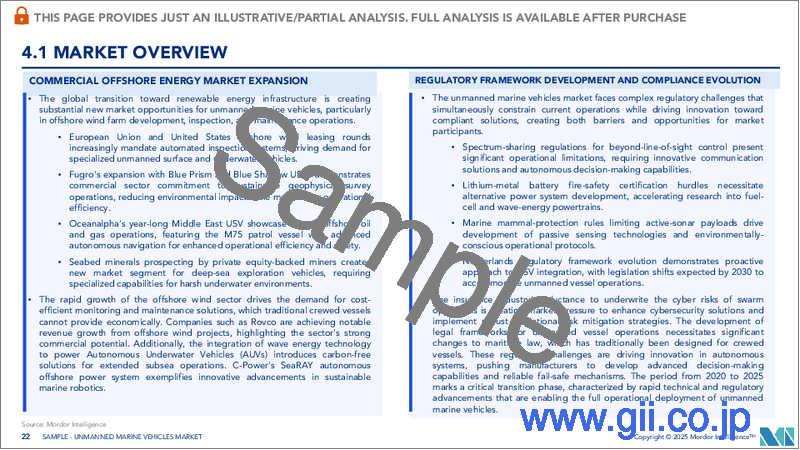|
|
市場調査レポート
商品コード
1687336
海洋無人機:市場シェア分析、産業動向・統計、成長予測(2025年~2030年)Unmanned Marine Vehicles - Market Share Analysis, Industry Trends & Statistics, Growth Forecasts (2025 - 2030) |
||||||
カスタマイズ可能
適宜更新あり
|
|||||||
| 海洋無人機:市場シェア分析、産業動向・統計、成長予測(2025年~2030年) |
|
出版日: 2025年03月18日
発行: Mordor Intelligence
ページ情報: 英文 140 Pages
納期: 2~3営業日
|
全表示
- 概要
- 目次
海洋無人機市場規模は2025年に53億5,000万米ドルと推定され、予測期間(2025-2030年)のCAGRは8.51%で、2030年には80億5,000万米ドルに達すると予測されます。

急速な技術開発により、高水深水中航行用の音響センサーが動向となっています。その目的は、一般的に高精度を採用している現在の水中ナビゲーションシステムのコストと待ち時間を削減することです。
主なハイライト
- 海洋監視は、無人海上ビークルが従来のシステムよりも監視、識別、迎撃能力が高いことから、防衛目的の市場を牽引しています。海洋無人機には、安定化武器システム、監視システム、赤外線ビジョンによる昼夜の監視が可能な電気光学追跡システムを装備できます。
- 運用コストの削減とプラットフォームの設計に加え、センサーの改良は、科学ペイロードの必要電力を削減することでコストを削減し、徐々に小型化するプラットフォームの使用を可能にします。センサー、プラットフォームの相互運用性、インターフェースの改善は、コストを大幅に削減します。
- 将来の自律型プラットフォームにとって理想的なセンサーは、コスト効率が高く、相互運用性があり、コンパクトで、ウェブに対応し、自己識別が可能なものです。費用対効果の高いセンサーは、無人海上航行体の大規模生産に適しており、測位、通信、小型化などの最新エレクトロニクスの特徴を活用できる可能性があります。障害物を安全に回避しながら航行するため、USVには視覚センサー、Light Detection and Ranging(LiDAR)、赤外線、ソナー、レーダーなど、さまざまなタイプのセンサーが使用されています。
- 水中マッピング、特に海洋地球科学研究のための無人海洋ビークルの使用量の増加は、市場の成長を促進すると予想されます。将来的には、地球システムの様々な安定状態の記録、ある安定状態から別の安定状態への進化の引き金となる事象の発見、気候やテクトニクス活動のような全く異なるシステムの状態間の関連性の特定がより重視されるようになり、無人海上ビークルの必要性が高まると思われます。
- しかし、UMVの高コストとそれに伴うメンテナンスの問題が、短期的には市場の妨げになるかもしれないです。この課題は、企業がより先進的なシステムを開発し、メンテナンス・サービスを提供するための専門知識を深めるにつれて、長期的には市場への影響を最小限に抑えられると予想されます。
- COVID-19の流行は海洋産業全体に悪影響を及ぼしており、クルーレス船舶も例外ではないです。ウイルスの蔓延を食い止めるために世界各国の政府が講じた様々な予防措置は、各業界のサプライチェーンを大きく混乱させ、世界的に数社の製造業務に支障をきたしました。
海洋無人機市場の動向
防衛産業が市場で大きく成長する見込み
- 海軍と国防省は、さまざまな任務や用途のために無人水上車両(USV)の使用にますます投資しています。自律型水中ビークル(AUV)や遠隔操作ビークル(ROV)は、機雷対策(MCM)作戦や対潜水艦戦(ASW)に使用される以外に、情報・監視・偵察(ISR)作戦に配備されるように設計されていることが多いです。
- 世界中の主要な防衛軍は、魚雷の脅威、水中機雷、ディーゼル電気潜水艦の攻撃、短距離対艦ミサイルなどの海洋安全保障上の脅威を経験しており、これは、海上や水面下の深さで動作する自律ロボットプラットフォームへの投資の多くを調整することにより、市場を牽引しています。
- ロボット・プラットフォームは、潜在的な水中脅威の特定や無力化など、特定の任務を遂行するために設計されています。これらの任務の成功は、位置認識、正確な位置情報、目標誘導を提供する周辺サブシステム(測位ビーコンや追跡システムなど)に依存しています。
- 2020年12月、トルコは、人工知能システムを使って遠隔操作される初の武装無人海上輸送船(SIDA)の進水を発表しました。この船舶は、特にトルコの主権がギリシャやフランスなどの国々から脅かされている地中海東部の問題海域において、同国の防衛ネットワークに貢献することが期待されています。
- さらに、海軍と海兵隊は2021年3月、米国における無人プラットフォームへの投資と統合の指針となる「無人キャンペーンフレームワーク」を発表しました。さらに、海軍と国の防衛システムを強化するための投資の増加は、防衛目的の海洋無人機の需要を開発するのに役立つと思われます。
- 様々な企業が防衛産業から海洋無人機の契約を獲得しようと努力しています。これも市場の成長・開拓につながっています。2022年8月、Leidosは米国海軍海システム司令部(NAVSEA)から中型の無人海中ビークルの設計・建造を受注したと発表されました。このコスト・プラス・フィーの契約は約3億5,800万米ドルです。
欧州は大幅な成長率が見込まれる
- 欧州は防衛と商業部門の需要により市場成長を遂げています。ASV海洋システムは、急速に成長している英国の産業です。英国のMaritime Autonomy Surface Testbed(MAST)は、革新的なブレードランナー(BLADERUNNER)の船体形状に着想を得た無人水上船舶(USV)で、すでにテムズ川の潮流で試験運用が行われています。MASTは、国防科学技術研究所(Dstl)からの研究資金援助を受けて、ポートチェスターを拠点とするASV Ltdが複数の新技術を受け入れるテストベッドとして開発しました。
- また、2021年5月、ドイツ連邦経済・エネルギー省は、新しい自律型潜水ロボットシステムを開発するための海事調査プログラムに1,200万ユーロを提供することを発表しました。この技術により、コストのかかる支援船を使わずに、深海の水中施設を自律的に監視し、二酸化炭素排出量を大幅に削減することが可能になると期待されています。今回の資金提供決定は、CIAM(包括的統合自律型水中監視ソリューションの共同開発)に参加するプロジェクト参加者9名に対して発表されました。
- イタリアのラ・スペツィアにあるNATO海洋研究実験センターは、MCMや対潜水艦戦(ASW)などの軍事用途のためのUUVの技術を進歩させるために地道な投資を行ってきました。CMREは現在、通信や相互協力が可能な無人ビークルのフリートの助けを借りて、戦闘員が地下深くにあるものをより明確に把握できるようにするために投資しています。
- 海洋環境の場合、戦闘の主な焦点が海洋から沿岸地域に進化したため、既存の海軍部隊が浅瀬で効果的に活動することが難しくなっています。そのため、フランスなどの欧州諸国では無人水中ビークル(UUV)の必要性が高まっています。
- 英国海軍は、産業界や国際的なパートナーとともに、エンジニアや科学者たちがUnmanned Warrior Eventで技術を実演し、将来の海戦に導入するアイデアを探る機会を設けた。これは、定期的な合同戦士艦隊演習と連動しており、作戦環境でシステムをテストすることを目的としています。
海洋無人機産業の概要
海洋無人機市場は、複数の老舗企業の存在により断片化されています。これらの企業は、買収、提携、事業拡大、製品・技術の発表などの戦略的イニシアティブを取り入れ、市場での地位を維持し競争優位を獲得しています。同市場の主要プレイヤーは、ジェネラル・ダイナミクス社、アトラス・エレクトロニクス社、シー・ロボティクス社などです。最近の市場開拓の動向は-。
- 2021年11月-SeaRobotics Corporationは、次世代ユーティリティクラスASVであるSR-Utility 3.0を発表しました。SRCのポートフォリオに追加されたこの最新モデルは、交換可能なペイロードやセンサーをサポートし、既存の計測機器を組み込める設定可能なプラットフォームをプロの測量士に提供することで、沿岸の無人海洋調査活動の範囲と汎用性を広げることを目的としています。
- 2021年3月- ゼネラル・ダイナミクス・ミッション・システムズは、2019年8月26日に海軍が発注した契約に基づき、地表地雷対策無人水中航行体システム「Knifefish」を納入しました。この契約は、成功したマイルストーンCの決定と低率初期生産(LRIP)開始の承認直後に締結されたもので、5台のKnifefishシステム(合計10台のUUV)とサポート機器を購入することになっています。
その他の特典
- エクセル形式の市場予測(ME)シート
- 3カ月間のアナリスト・サポート
目次
第1章 イントロダクション
- 調査の前提条件と市場定義
- 調査範囲
第2章 調査手法
第3章 エグゼクティブサマリー
第4章 市場概要
- 市場概要
- 産業バリューチェーン分析
- 業界の魅力度-ポーターのファイブフォース分析
- 新規参入業者の脅威
- 買い手の交渉力
- 供給企業の交渉力
- 代替品の脅威
- 競争企業間の敵対関係の強さ
- COVID-19の市場への影響評価
第5章 市場力学
- 市場促進要因
- 防衛目的の海洋監視
- 海洋地球科学研究のための水中マッピングにおける無人海上探査機の利用増加
- 市場抑制要因
- 装置の高コストとメンテナンスの問題
第6章 技術概要
第7章 市場セグメンテーション
- タイプ
- 海面機
- 水中機
- 制御タイプ
- 遠隔操作
- 自律
- 用途
- 防衛
- 調査
- 商用
- その他の用途
- 地域
- 北米
- 米国
- カナダ
- 欧州
- ドイツ
- イタリア
- フランス
- その他欧州
- アジア太平洋
- 中国
- 日本
- インド
- オーストラリア
- その他アジア太平洋地域
- ラテンアメリカ
- ブラジル
- その他ラテンアメリカ
- 中東・アフリカ
- 南アフリカ
- その他中東とアフリカ
- 北米
第8章 競合情勢
- 企業プロファイル
- General Dynamics
- Atlas Elektronik
- Sea Robotics Inc.
- Liquid Robotics
- Rafael Advanced Defense Systems
- BAE Systems
- Ocean Aero Inc.
- Pelorus Naval Systems
- Thales Group
- ECA Group
- Textron Inc.
- Teledyne Technologies Inc.
- Northrop Grumman
- ASV Global
第9章 投資分析
第10章 市場の将来
The Unmanned Marine Vehicles Market size is estimated at USD 5.35 billion in 2025, and is expected to reach USD 8.05 billion by 2030, at a CAGR of 8.51% during the forecast period (2025-2030).

With rapid technological development, acoustic sensors for high underwater navigation are on trend. The aim is to reduce the cost and latency of current underwater navigation systems that typically employ high accuracy.
Key Highlights
- Oceanic surveillance is driving the market for defense purposes as unmanned marine vehicles offer greater capacity for surveillance, identification, and interception than traditional systems. They can be equipped with stabilized weapons systems, surveillance systems, and electro-optical tracking systems capable of monitoring day and night using infrared vision.
- In addition to operational cost reductions and platform design, improvements in sensors would reduce costs by reducing science payload power requirements and enable the usage of progressively smaller platforms. Improved sensors, platforms' interoperability, and interfaces would significantly reduce costs.
- The ideal sensor for future autonomous platforms would be cost-effective, interoperable, compact, web-enabled, and self-identifying. Cost-effective sensors may be suitable for the large-scale production of unmanned marine vehicles and could utilize features of modern electronics, such as positioning, communication, and miniaturization. Various sensor types, such as vision sensors, Light Detection and Ranging (LiDAR), infrared, sonar, and radar, are used on USVs to navigate while avoiding obstacles safely.
- Increased usage of unmanned marine vehicles for underwater mapping, particularly for marine geoscience studies, is expected to drive the market's growth. More emphasis in the future will be directed toward documenting the various stable states of Earth's systems, discovering what events trigger evolution from one stable state to another, and identifying the linkages between the states of very different systems like climate and tectonics activity, which will drive the need for unmanned marine vehicles.
- However, the high cost of UMVs and the associated maintenance issues may hinder the market in the short term. This challenge is expected to minimize its impact on the market in the long run as companies develop more advanced systems and gain more expertise in providing maintenance services.
- The COVID-19 pandemic has negatively impacted the overall marine industry, and crewless marine vehicles are no exception. Various preventive measures that various governments took across the world to contain the spread of the virus severely disrupted the supply chains across industries and hampered the manufacturing operations of several companies globally.
Unmanned Marine Vehicles Market Trends
The Defense Industry is Expected to Grow Significantly in the Market
- The Navy and Defense departments are increasingly investing in the use of unmanned surface vehicles (USVs) for various missions and applications. The autonomous underwater vehicles (AUVs) and remotely operated vehicles (ROVs) are often designed to be deployed for intelligence, surveillance, and reconnaissance (ISR) operations, apart from being used for mine countermeasure (MCM) operations and anti-submarine warfare (ASW).
- The primary defense forces across the world are experiencing maritime security threats such as torpedo threats, underwater mines, diesel-electric submarine attacks, and short-range anti-ship missiles, which is driving the market by gearing more of its investments toward autonomous, robotic platforms that operate at sea and depths well below the surface.
- The robotic platforms are designed to accomplish specific tasks, such as identifying and neutralizing potential underwater threats. The successful completion of these missions depends on the peripheral subsystems, which provide location awareness, accurate positional information, and target guidance, such as positioning beacons and tracking systems.
- In December 2020, Turkey announced the launch of its first armed unmanned maritime vehicle (SIDA), which will be operated remotely using artificial intelligence systems. The vessel is expected to contribute to the country's defense network, especially in the troubled waters of the eastern Mediterranean, where Turkey's sovereignty rights have come under threat from countries like Greece and France.
- Moreover, in March 2021, the Navy and the Marine Corps published the Unmanned Campaign Framework to guide their investments in and integration of unmanned platforms in the United States. Further, increasing investments in strengthening the navy and the country's defense systems shall aid in developing the demand for unmanned marine vehicles for defense purposes.
- Various companies are making efforts to get unmanned marine vehicle contracts from the defense industry. This is also resulting in the growth and development of the market. In August 2022, Leidos was announced to have been selected by the U.S. Naval Sea Systems Command (NAVSEA) for designing and building a medium-size unmanned undersea vehicle. The cost-plus-fixed-fee contract holds an approximate value of USD 358 million.
Europe is Expected to Witness Significant Growth Rate
- Europe is gaining market growth due to the defense and commercial sector demand. The ASV marine system is a rapidly growing United Kingdom Industry. The United Kingdom's Maritime Autonomy Surface Testbed (MAST), which is an unmanned surface vessel (USV) inspired by the innovative BLADERUNNER hull shape, has already undergone trials in the Tidal Thames. With the help of research funding from the Defense Science and Technology Laboratory (Dstl), MAST was developed by Portchester-based ASV Ltd to provide a testbed to host multiple new technologies.
- Also, in May 2021, the German Federal Ministry for Economic Affairs and Energy announced facilitating EUR 12.0 million for the Maritime Research Program to develop a novel autonomous submersible robotics system. The technology is expected to enable autonomous monitoring of underwater installations in the deep sea with a significant carbon footprint reduction without costly support vessels. The funding decision was announced to the project's nine participants in the CIAM (Cooperative Development of a Comprehensive Integrated Autonomous Underwater Monitoring Solution).
- The NATO Centre for Maritime Research and Experimentation, located in La Spezia, Italy, has invested steadily to advance the technology of UUVs for military applications like MCM and antisubmarine warfare (ASW). CMRE is currently investing in helping warfighters get a clearer picture of what lies in the depths below, with the help of the fleet of unmanned vehicles that can communicate and cooperate with each other.
- In the case of the maritime environment, as the prime focus of combat has evolved from ocean to coastal areas, it is getting difficult for the existing naval forces to operate in shallow waters effectively. Therefore, unmanned underwater vehicles (UUVs) are being required by European nations such as France at an increasing pace.
- Along with industry and international partners, the Royal Navy has created an opportunity for engineers and scientists to demonstrate the technology during the Unmanned Warrior Event and explore the ideas to implement in the future of naval warfare. It is linked with the regular Joint Warrior Fleet Exercise and aims to test systems in an operational environment.
Unmanned Marine Vehicles Industry Overview
The unmanned marine vehicles market is fragmented due to the presence of several well-established players. These players incorporate strategic initiatives such as acquisitions, partnerships, expansions, and product/technology launches to maintain their positions and gain a competitive advantage in this market. Key players in the market are General Dynamics, Atlas Elektronik, Sea Robotics Inc., etc. Recent developments in the market are -
- November 2021 - SeaRobotics Corporation announced the SR-Utility 3.0, next-generation Utility Class ASV. The latest addition to the SRC portfolio is intended to broaden the scope and versatility of unmanned coastal marine survey activities by providing professional surveyors with a configurable platform that supports interchangeable payloads and sensors and incorporates existing instrumentation.
- March 2021 - General Dynamics Mission Systems delivered the Knifefish surface mine countermeasure unmanned underwater vehicle system under a contract awarded by the Navy on August 26, 2019. The contract, which was awarded immediately following a successful Milestone C decision and approval to enter low-rate initial production (LRIP), calls for the purchase of five Knifefish systems (10 total UUVs) and support equipment.
Additional Benefits:
- The market estimate (ME) sheet in Excel format
- 3 months of analyst support
TABLE OF CONTENTS
1 INTRODUCTION
- 1.1 Study Assumptions and Market Definition
- 1.2 Scope of the Study
2 RESEARCH METHODOLOGY
3 EXECUTIVE SUMMARY
4 MARKET OVERVIEW
- 4.1 Market Overview
- 4.2 Industry Value Chain Analysis
- 4.3 Industry Attractiveness - Porter's Five Forces Analysis
- 4.3.1 Threat of New Entrants
- 4.3.2 Bargaining Power of Buyers
- 4.3.3 Bargaining Power of Suppliers
- 4.3.4 Threat of Substitute Products
- 4.3.5 Intensity of Competitive Rivalry
- 4.4 Assessment of the Impact of COVID-19 on the Market
5 MARKET DYNAMICS
- 5.1 Market Drivers
- 5.1.1 Oceanic Surveillance for Defense Purposes
- 5.1.2 Increased Usage of Unmanned Marine Vehicles for Underwater Mapping for Marine Geoscience Studies
- 5.2 Market Restraints
- 5.2.1 High Cost for the Equipment and Maintenance Issues
6 TECHNOLOGICAL OVERVIEW
7 MARKET SEGMENTATION
- 7.1 Type
- 7.1.1 Surface Vehicle
- 7.1.2 Underwater Vehicle
- 7.2 Control Type
- 7.2.1 Remotely Operated
- 7.2.2 Autonomous
- 7.3 Application
- 7.3.1 Defense
- 7.3.2 Research
- 7.3.3 Commercial
- 7.3.4 Other Applications
- 7.4 Geography
- 7.4.1 North America
- 7.4.1.1 United States
- 7.4.1.2 Canada
- 7.4.2 Europe
- 7.4.2.1 Germany
- 7.4.2.2 Italy
- 7.4.2.3 France
- 7.4.2.4 Rest of Europe
- 7.4.3 Asia-Pacific
- 7.4.3.1 China
- 7.4.3.2 Japan
- 7.4.3.3 India
- 7.4.3.4 Australia
- 7.4.3.5 Rest of Asia-Pacific
- 7.4.4 Latin America
- 7.4.4.1 Brazil
- 7.4.4.2 Rest of Latin America
- 7.4.5 Middle-East and Africa
- 7.4.5.1 South Africa
- 7.4.5.2 Rest of Middle-East and Africa
- 7.4.1 North America
8 COMPETITIVE LANDSCAPE
- 8.1 Company Profiles
- 8.1.1 General Dynamics
- 8.1.2 Atlas Elektronik
- 8.1.3 Sea Robotics Inc.
- 8.1.4 Liquid Robotics
- 8.1.5 Rafael Advanced Defense Systems
- 8.1.6 BAE Systems
- 8.1.7 Ocean Aero Inc.
- 8.1.8 Pelorus Naval Systems
- 8.1.9 Thales Group
- 8.1.10 ECA Group
- 8.1.11 Textron Inc.
- 8.1.12 Teledyne Technologies Inc.
- 8.1.13 Northrop Grumman
- 8.1.14 ASV Global






